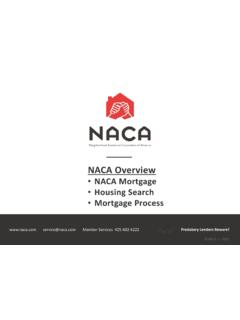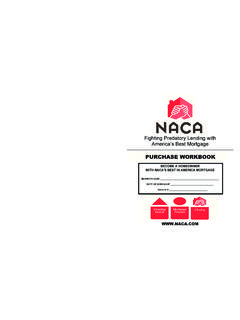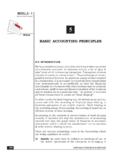Transcription of MEMBER’S INITIAL ASSESSMENT - NACA
1 MEMBER'S INITIAL ASSESSMENT . Row income , PSS & MRF Member's #. Financial ASSESSMENT Example Info 1. income . 2. Number of adults earning income who will reside in 2 adult incomes your future household. 3. Individual Monthly Gross Incomes W-2 Hourly 1. $15hr x 40hrs x Example: $15 per hour times 40 hours per week, 52wks 12 = $2,600. times 52 weeks for annual income , divide by 12 for gross monthly income . 2. $36,000 12 = $3,000. 4. Monthly Gross income W-2 Household salaries $2,600+$3,000 = 5,600. 5. Monthly Gross income W-2 Household Commission $0. 6. Monthly Gross income Self-employed income $0. 7. Total Gross Monthly income : $5,600 ( income ) 0. 8. DEBTS $500 (Debts). (car payments, student loans, credit card minimum payments, etc.). Total Monthly Debts: 9. MAXIMUM AFFORDABLE PAYMENT. 10. Current Rent $1,200. 11. Housing Ratio: $5,600 x.
2 31= $1,736. Multiply total gross monthly income (Row 7) by 31%. (31% of your gross monthly income is the maximum that can go toward your mortgage payment). 12. Debt Ratio: $5,600 x .40 - $500 =. Multiply your gross monthly income (Row 7) by 40%, $1,740. and subtract your monthly debts (Row 8) (40% of your gross monthly income minus all monthly debt obligations is your maximum payment). 13. Maximum Affordable Payment: $1,200 (PITI). Take the lowest of: Rent (Row 10), Housing Ratio (Row 11), or Debt Ratio (Row 12). This is your maximum affordable mortgage payment covering PITI. 14. Maximum Affordable Payment Increase: 15. Payment Shock Savings: $1,736 $1,200 =. Deduct current rent (Row 10) from the lower of the $536 (PITI Increase). Housing Ratio (row 11) or Debt Ratio (row 12) to determine your PSS amount (PSS). You need to save this amount as if you were already making the higher mortgage payment to demonstrate your ability and willingness to afford the higher mortgage payment.
3 The PSS is not necessary if you want a mortgage payment not exceeding your affordable current rent, unless you are paying your rent and other expenses with increased debts or reduced your savings. 16. MAXIMUM LOAN AMOUNT. 17. Monthly Homeowner's Insurance (HOI): $50. This estimated amount will likely be greater depending on the value of the property, type of structure, insurance company and other factors. 18. Monthly Real Estate taxes: $200. The calculation is: purchase price x tax rate 12. The rate varies per area as it is determined by the tax assessor for each county. Typically, they are about 1% to 4% of the value of the property. Your counselor can assist with the rate in your area. 19. Principal & Interest Payment: $1,200 PITI. Deduct the estimated homeowner's insurance (Row -$50 (Insurance). 17) and the estimated monthly real estate taxes (Row -$200 (RE Taxes).)
4 18) from your Maximum Affordable Payment (Row $950 P&I Payment 13). This will be the amount left to cover principle and interest of your loan. 20. Maximum Loan Amount: $211,560. Using mortgage tables below and in the workbook (30 ( - 30-yr). or 15 year-term table) take the Principal & Interest (Mort. Amount). Payment (Row 19) and find the column for today's rate or the closest to today's rate (available at ) and find the monthly payment closest to your affordable payment. The column on the far left under Mortgage Amount will indicate the loan amount based on your affordable monthly payment. You can increase your maximum loan amount by using your savings and/or government assistance to reduce your principal or permanently buy-down the interest rate. Using the NACA Buy-Down each discount point ( one percent of the mortgage amount) permanently reduces the interest rate by one-sixth from the already below market rate.
5 Thus, the formula is: Number of points x = percent rate reduction from starting rate. 21. MINIMUM REQUIRED FUNDS (MRF). 22. Current Funds: $3,000. Amount of funds in all your accounts combined checking, savings, and cash at home (any cash kept at home must be deposited into your bank account as soon as possible). You will need to have a minimum of $2,500 to be NACA Qualified to cover the out of pocket cost for: earnest money deposit (credited at closing); home inspection; and prepayment for home owner's insurance, real estate taxes, and mortgage interest for the month you move in. You will also need a reserve of 1 to 3 months of mortgage payments for single units and up to 6 months for multi-unit. 23. Property Inspection: $500. Funds allocated to pay a licensed inspector to assess the structure, safety and health condition of the property.
6 The cost varies per inspection and per region costing approximately $500 or more depending on the property type. It will likely be more for a multi- family and a possible reinspection 24. Pre-paid Homeowners Insurance: 15 months x $50 = $750. 12 months of Homeowner's Insurance that must be paid in advance at closing plus 3 months to open the escrow account for a total of 15 months prepaid. 25. Pre-paid Real Estate Taxes: $200 x 3 = $600. You will pay about 3 to 6 months of real estate taxes which will depend on your region and the month you close 26. Pre-paid Mortgage Interest: $211,560 x .0350. You will not pay a mortgage payment the first month 365 Days x 15 days =. when you move in, but you will be required to pay the $304. interest rate from the date you close to the end of that month. Calculation: Loan Amount x multiply by current interest rate 365 (days in the calendar year for the daily rate) x number of days from the estimated closing date to the end of the month.
7 27. MRF - Reserves: $1,200 - One month of You must save one to six months PITI for reserve PITI. funds to be available after you close based on the following criteria: One-month reserve if PSS less than $300;. Two-months reserve if PSS is greater than $300;. Three months reserves self-employment income ;. Four months reserves if two-family property;. Five months reserves if a three-family property;. Six months reserves if a four-family or mixed-use property. 28. Minimum Required Funds: $500 Inspection Add together Property Inspection (Row 23) + Pre- + $750 HOA. 0. Paid Homeowners Insurance (Row 24) + Pre-Paid + $600 RE. Real Estate Taxes (Row 25) + Pre-Paid Interest (Row + $304 Interest 26) + Reserves (Row 27) to determine the Minimum + $1,200 Reserves Required Funds. The MRF could be higher if there is $3,354 (MRF). a HOA fee required at closing 29.
8 MRF Additional Requirement: $3,000 MRF. Subtract Minimum Required Funds (Row 28) from -$3,354 Funds Current Assets (Row 22). If the number is negative, -$354 MRF Short you must increase your funds by this amount. With your counselor, use the budget to determine how long it will take to save this amount, unless you can count on other funds such as a gift from a relative, tax return, etc.











